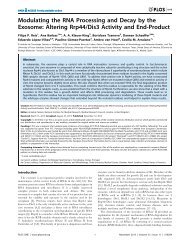<strong>Proteomics</strong> 2011, 11, 1559–1568 1565once these centers are up and running, efforts willbe made to include Africa and Middle-Easternregions into the fold. Further extension will dependon their necessity. Provide and distribute a newsletterand published articles to each and everymember of INPPO and also to those interested nonmembersto keep them abreast of the latest developmentsin plant proteomics, because with knowledgecomes the option of doing something fruitful, andevery student, post-doc or researcher, can contributesomething.(vi) Organize workshops at national and international levelsto train manpower and exchange information: Thiswill be a global venue for plant proteome researchersto present, hear and discuss their individual plantsand their proteomes. We will need support fromuniversities, industries and governments at thisfounding stage to help with training a new generationof young scientists, especially from developing countriesin pursuing professional careers in plantproteomics.(vii) Integrate proteomics-related activities and disseminatethem to partners through the INPPO website: As theinformation is the key of success, one such activity thisinitiative will involve is to enrich the scientificcommunity by providing access to information andpublished articles in the field of plant proteomics. Thiswill lead to an acceleration in plant proteomicsresearch.(viii) Bring proteomics to every laboratory working on plantsaround the globe: This is critical as each country andlaboratory has something to give. For example,developing countries may lag behind in facilities toconduct research on a global scale, but they may beable to help with talented manpower in bioinformaticsand computer science to help speed up the process ofhandling, analyzing and extracting biologically meaningfuldata.(ix) Aim to outreach to the younger generation students at theschool, college and university levels: Engagement ofstudents is essential in order to assure the future ofplants and their proteomes, and with them, our planet.(x) Help translate the proteomics knowledge into biology andvice versa: Think ‘out of the box.’On the way to achieving these initiatives, INPPO willactively work to be self-sustainable. To do so, and achieveour common goals, we need all interested parties tojoin us at INPPO (Fig. 5) in this endeavor. Nothing isimpossible, if we work together, and history is evidence forthat.6 Addressing INPPO – An outlineThe initiatives discussed will be addressed in multiplephases. The initial phase of INPPO will be to:(i) Circulate this message through websites (includingINPPO and plant/proteomics-related journals) to allpeople (researchers and students) involved in proteomicsin plants, globally. At this step the importance ofINPPO, its goals and initiatives will be introduced anddiscussed, in order to get feedback (ideas/reactions/comments via INPPO website). This will lead torecruitment of members of INPPO in all areas.(ii) Install at least two representatives from each participatingcountry.(iii) Launch INPPO.(iv) Organize a meeting of the founding members tofurther discuss and chalk out the next phases ofINPPO, such as to organize an international meetingon INPPO with the initiators, founding members,representative and supporting members from aroundthe globe for discussing a governing body, initiatives,and most importantly funding from governments andprivate sectors.Figure 5. Join us at INPPO (http://www.inppo.com). Each piece ofthe puzzle represents a major plant/crop proteome in eachcontinent/region/country. INPPO will function globally to linkthem together.Authors appreciate the help of Ms. Junko Shibato (NationalInstitute of Environmental Studies, NIES, Tsukuba, Japan) indesigning the logo of INPPO and Raj Agrawal (Computerengineer and programmer) in designing and taking care of theINPPO website. R. R. also acknowledges the great support ofProfessors Seiji Shioda (Department of Anatomy I, School ofMedicine, Showa University) and Yoshinori Masuo (Departmentof Biology, Faculty of Science, Toho University) inpromoting inter-disciplinary research and unselfish encouragement.The authors have declared no conflict of interest.& 2011 WILEY-VCH Verlag GmbH & Co. KGaA, Weinheimwww.proteomics-journal.com
1566 G. K. Agrawal et al. <strong>Proteomics</strong> 2011, 11, 1559–15687 References[1] Wilkins, M. R., Sanchez, J. C., Gooley, A. A., Appel, R. D.et al., Progress with proteome projects: why all proteinsexpressed by a genome should be identified andhow to do it. Biotechnol. Genet. Eng. Rev. 1995, 13,S19–S50.[2] Aebersold, R., Mann, M., Mass spectrometry-basedproteomics. Nature 2003, 422, 198–207.[3] Dunkley, T. P., Watson, R., Griffin, J. L., Dupree, P., Lilley,K. S., Localization of organelle proteins by isotope tagging(LOPIT). Mol. Cell. <strong>Proteomics</strong> 2004, 3, 1128–1134.[4] Mikesh, L. M., Ueberheide, B., Chi, A., Coon, J. J. et al., Theutility of ETD mass spectrometry in proteomic analysis.Biochim. Biophys. Acta 2006, 1764, 1811–1822.[5] Cox, J., Mann, M., Is proteomics the new genomics? Cell2007, 130, 395–398.[6] Haynes, P. A., Roberts, T. H., Subcellular shotgun proteomicsin plants: looking beyond the usual suspects. <strong>Proteomics</strong>2007, 7, 2963–2975.[7] Wolff, S., Antelmann, H., Albrecht, D., Becher, D. et al.,Towards the entire proteome of the model bacteriumBacillus subtilus by gel-based and gel-free approaches.J. Chromatogr. B Analyt. Technol. Biomed. Life Sci. 2007,849, 129–140.[8] Agrawal, G. K., Rakwal, R., in: Agrawal, G. K., Rakwal, R.(Eds.), Plant <strong>Proteomics</strong>: Technologies, Strategies, andApplications, Wiley & Sons, Hoboken, NJ 2008.[9] Baerenfaller, K., Grossmann, J., Grobei, M. A., Hull, R. et al.,Genome-scale proteomics reveals Arabidopsis thalianagene models and proteome dynamics. Science 2008, 320,938–941.[10] Bradshaw, R. A., An introduction to proteomics: applicationsto plant biology, in: Agrawal, G. K., Rakwal, R. (Eds.),Plant <strong>Proteomics</strong>: Technologies, Strategies, and Applications,Wiley & Sons, Hoboken, NJ 2008, pp 1–6.[11] Weckwerth, W., Baginsky, S., van Wijk, K. J., Heazlewood,J. L., Millar, H., The multinational Arabidopsis steeringsubcommittee for proteomics assembles the largestproteome database resource for plant systems biology.J. Proteome Res. 2008, 7, 4209–4210.[12] Gianazza, E., Righetti, P. G., Immobilized pH gradients.Electrophoresis 2009, 30, S112–S121.[13] Gorg, A., Drews, O., Luck, C., Weiland, F., Weiss, W., 2-DEwith IPGs. Electrophoresis 2009, 30, S122–S132.[14] Guex, N., Peitsch, M. C., Schwede, T., Automatedcomparative protein structure modeling with SWISS-MODEL and Swiss-PdbViewer: a historical perspective.Electrophoresis 2009, 30, S162–S173.[15] Klose, J., From 2-D electrophoresis to proteomics. Electrophoresis2009, 30, S142–S149.[16] Majeran, W., van Wijk, K. J., Cell-type-specific differentiationof chloroplasts in C4 plants. Trends Plant Sci. 2009, 14,100–109.[17] Rabilloud, T., Membrane proteins and proteomics: love ispossible, but so difficult. Electrophoresis 2009, 30, S174–S180.[18] Wilkins, M. R., Hares and tortoises: the high- versuslow-throughput proteomic race. Electrophoresis 2009, 30,S150–S155.[19] Yates, J. R., 3rd, Ruse, C. I., Nakorchevsky, A., <strong>Proteomics</strong>by mass spectrometry: approaches, advances, and applications.Annu. Rev. Biomed. Eng. 2009, 11, 49–79.[20] Rothstein, S. J., Returning to our roots: making plant biologyresearch relevant to future challenges in agriculture.Plant Cell 2007, 19, 2695–2699.[21] The Arabidopsis Genome Initiative. Analysis of the genomesequence of the flowering plant Arabidopsis thaliana.Nature 2000, 408, 796–815.[22] Goff, S. A., Ricke, D., Lan, T. H., Presting, G. et al., A draftsequence of the rice genome (Oryza sativa L. ssp. japonica).Science 2002, 296, 92–100.[23] Yu, J., Hu, S., Wang, J., Wong, G. K. et al., A draft sequenceof the rice genome (Oryza sativa L. ssp. indica). Science2002, 296, 79–92.[24] International Rice Genome Sequencing Project. The mapbased sequence of the rice genome. Nature 2005, 436,793–800.[25] Tuskan, G. A., DiFazio, S., Jansson, S., Bohlmann, J. et al.,The genome of black cottonwood, Populus trichocarpa(Torr. & Gray). Science 2006, 313, 1596–1604.[26] Lu, C., Wallis, J. G., Browse, J., An analysis of expressedsequence tags of developing castor endosperm usinga full-length cDNA library. BMC Plant Biol. 2007,7, 42.[27] Bedell, J. A., Budiman, M. A., Nunberg, A., Citek, R. W. et al.,Sorghum genome sequencing by methylation filtration.PLoS Biol. 2005, 3, e13.[28] Jaillon, O., Aury, J. M., Noel, B., Policriti, A. et al., Thegrapevine genome sequence suggests ancestral hexaploidizationin major angiosperm phyla. Nature 2007, 449,463–467.[29] Schmutz, J., Cannon, S. B., Schlueter, J., Ma, J. et al.,Genome sequence of the palaeopolyploid soybean. Nature2010, 463, 178–183.[30] Schnable, P. S., Ware, D., Fulton, R. S., Stein, J. C. et al., TheB73 maize genome: complexity, diversity, and dynamics.Science 2009, 326, 1112–1115.[31] Ward, D. C., White, D. C., The new ’omics era. Curr. Opin.Biotechnol. 2002, 13, 11–13.[32] Hennig, L., Patterns of beauty – omics meets plant development.Trends Plant Sci. 2007, 12, 287–293.[33] Wienkoop, S., Morgenthal, K., Wolschin, F., Scholz, M.et al., Integration of metabolomic and proteomic phenotypes:analysis of data covariance dissects starch and RFOmetabolism from low and high temperature compensationresponse in Arabidopsis thaliana. Mol. Cell. <strong>Proteomics</strong>2008, 7, 1725–1736.[34] Megason, S. G., Fraser, S. E., Imaging in systems biology.Cell 2007, 130, 784–795.[35] Long, T. A., Brady, S. M., Benfey, P. N., Systems approachesto identifying gene regulatory networks in plants. Annu.Rev. Cell Dev. Biol. 2008, 24, 81–103.& 2011 WILEY-VCH Verlag GmbH & Co. KGaA, Weinheimwww.proteomics-journal.com

















